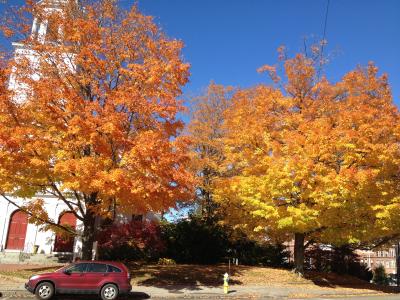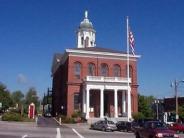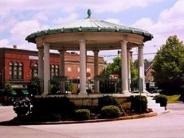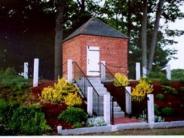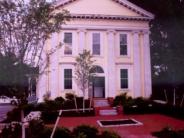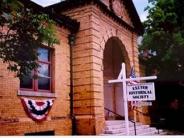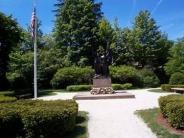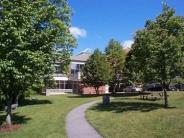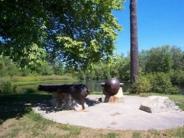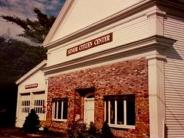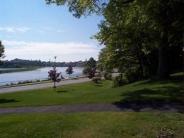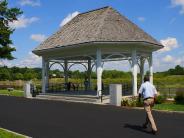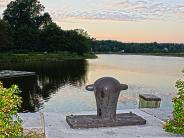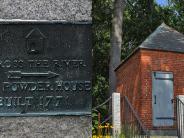Places of Interest
Exeter is a walkable, historical town. Buildings and sites within the town represent the best of the past and present of the seacoast area, New Hampshire, and the country as a whole. We encourage you to visit and experience our community.
Exeter was originally settled in 1638 by Reverend John Wheelwright and has been an important location in the New England region ever since. Exeter served as the revolutionary war capital of New Hampshire. In addition, Exeter functioned as a seaport in the late 1600's and early to late 1700's, primarily along what is now Swasey Parkway, at the mouth of the Squamscott River.
Exeter is home to many recreational areas and parks, and has many indoor and outdoor activities for families. Important town landmarks, like Philips Exeter Academy (PEA), Swasey Parkway, the Town Hall, Ladd Gilman House, Folsom Tavern, and the American Independence Museum, are great places to visit while in the area.
Below are just some highlights of sites you will find in Exeter.
The Swasey Parkway
Swasey Parkway, located at the lower part of Water Street, was a gift to the Town of Exeter from Ambrose Swasey in November 1931. The Parkway follows the Squamscott River and is lined with trees and park benches for all to enjoy. The park is open dawn to dusk and provides the scenic setting for the Powder Keg Beer and Chili Festival, held in October of each year.
A Pavilion was completed on the Parkway in 2007 and serves as the site for multiple concert events on Thursday nights in the summer. The park is the perfect place for outdoor activities, including jogging, picnics, walking, or just enjoying the fresh air. We ask that you please do not feed the animals including seagulls, ducks, and geese that visit the parkway.
Exeter Country Club - Jady Hill
The Exeter Country Club was founded in 1889. This reasonably priced nine-hole golf course is available for both members and the public, so call or schedule a tee-time online. Come enjoy golf or just sit outside at the Grill on the Hill with a cool drink or beer. Full menu available. Special twilight rates are also available. http://www.exetercountryclub.com/
The Town Hall - 9 Front Street, corner of Front and Water Streets
The Exeter Town Hall was built in 1855, and remains one of the Town's most photographed and iconic buildings. The main hall is still used for public meetings, plays, and other events, and is commonly rented by civic groups and others as an "open forum" throughout the year. The Statue of Lady Justice that is on top of the cupola was put there in 1855 when the building was built. In 1917 the Statue was brought down for repairs after a bad storm. The Statue stayed there until it was severely damaged by "Hurricane Bob" in August 1991. This time the statue was replaced, with no changes, in July 1992. The fee to use the facility is set by the Select Board and more information can be obtained by calling the Town Offices at 773-6102 or emailing mroy@exeternh.gov.
Exeter Public Library - Founders Park, corner of String Bridge and Pleasant Street
The Exeter Public Library was built in 1987 on land donated to the Town by the Milliken Company, former owners of the Exeter Mills. The Library is part of Founder's Park, which was created in 1988 to commemorate the 350th anniversary of the founding of the Town of Exeter (1638-1988). The public library is open to all and you can click here for hours and programs.
The Gale Park War Memorial - Linden and Front Streets
The land for the Gale Park War Memorial & Park at the corner of Linden Street & Front Street was donated to the Town of Exeter by Alice Gale Hobson, in memory of her father, General Stephen H. Gale. The statue was created by one of Exeter's most famous residents, Daniel Chester French. The Park & War Memorial was dedicated on July 4, 1922. Gale Park is open and available for public enjoyment.
The Powder House -- Off Jady Hill Avenue at Duck Point, adjacent to Exeter Mills Apartments
The Powder House was built in 1771. It is located at Duck Point, and can be seen across the river from Swasey Parkway. On December 17, 1812, the State Legislature passed a resolution empowering the Governor to purchase a supply of powder, lead and flints for the use of the State. (The War of 1812) Half of this material was to be stored in Exeter, and the Governor was authorized to "procure some suitable magazines, or safe place of deposit - for the safe keeping of the public stores aforesaid". It is also thought that a number of barrels were stored in the Powder House and used at the Battle of Bunker Hill. The Powder House still stands today and was refurbished in 1999.
The Exeter Historical Society - 47 Front street
Exeter loves its history, and the Exeter Historical Society was founded in 1928. It is now located at 47 Front Street, the only yellow brick building in the area. The Historical Society has a museum and a library for all to see and enjoy. The building was originally built and served as the first town public Library in 1893. It also serves as a Civil War Memorial for the community. Many important pieces from Exeter's history are on display here, including Native American artifacts and pieces from President Lincoln's visit to the Town as part of the "Cooper Union" speech tour in 1860. The Historical Society has many entertaining and educational programs and displays throughout the year. The society has a digital walking tour app available on their website.
Gilman Park - Court Street and Bell Avenue
Gilman Park, located off Bell Avenue via Court Street, was a gift to the Town of Exeter from Daniel Gilman in 1891. A youth baseball field and outdoor basketball court are located at the park. Residents and travelers alike enjoy the peaceful confines of the park which also includes a walking trail, footbridge, and access to Phillips Exeter Academy grounds.
Two cannons located at Gilman Park were offered to the Town for decorative purposes by the United States Naval Department in 1897. The gift came with a restriction: in case of need the cannons could be recalled by the government. To date, they never have.
Gilman Park was formally acquired by the Town in 2012 after years of being administered by a trust, and is now is held in a conservation easement by the Southeast Land Trust. Tucked away on Bell Avenue and linked to PEA, Gilman Park offers a quiet space to walk, play catch, or just enjoy nature.
The Bandstand (aka the Swasey Pavilion)
The Bandstand that is located at the intersection of Water & Front Streets was a gift to the Town of Exeter from Ambrose Swasey in 1916. It replaced a wooden bandstand that was in the same location that was built in 1895.
The Exeter Brass Band was founded in 1847 and has held summer concerts ever since. Concerts happen at the bandstand each Monday night in July, beginning at 7:30 p.m.. Brass band concerts are recorded and show periodically on community access channel 98, which is available to Comcast subscribers.
The Bandstand remains the hub of Downtown Exeter and the Historic District. Many of the town's most pleasant structures are located within a stones throw of this location.
The American Independence Museum - Center Street and Water Street
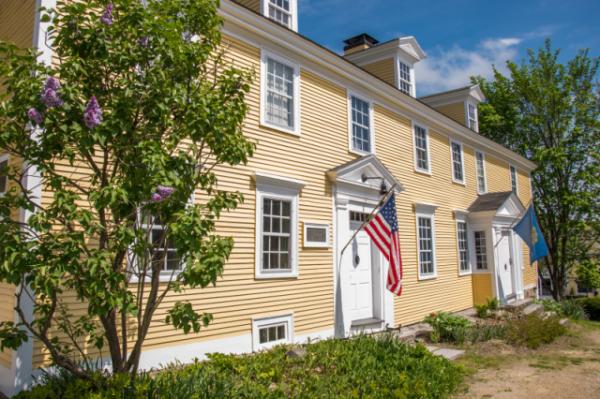
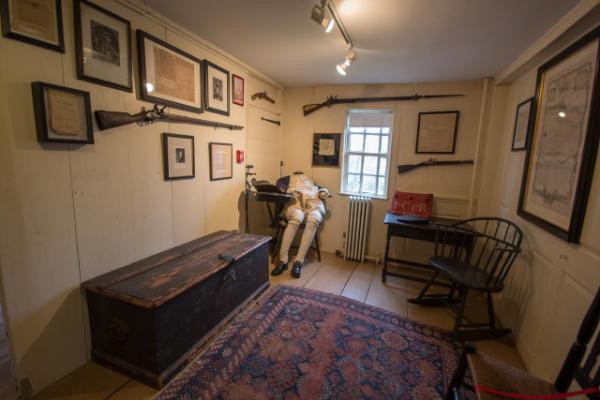
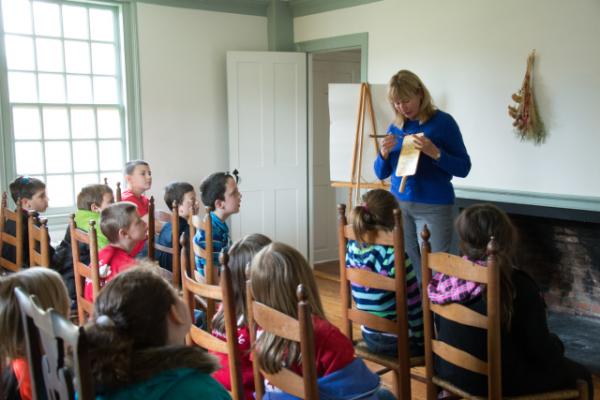
The American Independence Museum is an part of Exeter's history and the history of the United States. One of the original printings of the Declaration of Independence was found in Exeter and is now held at the Museum. They also hold two original drafts of the U.S. Constitution. The Museum grounds include the Ladd-Gilman House, which holds many important artifacts from when Exeter was New Hampshire's State Capital during the Revolutionary War. The Folsom Tavern also resides on the Museum's premises. The Tavern was visited by President Washington in 1789 when he toured New England. The Museum holds a festival each year typically on the third Saturday in July. The Festival includes a revolutionary battle re-enactment on Swasey Parkway, a variety of period crafts and historical re-enactments in the Folsom Tavern. In 2012, Red Hook Breweries partnered with the Museum to introduce "American Independence Ale" in a limited edition.
Gilman Garrison House - Water Street
Built in 1709, the Gilman Garrison House was the home to the original Gilman family. Owners of Exeter's first sawmills, the Gilman family constructed a beautiful building and continually added on to the original building throughout the eighteenth century. The building was restored by William Dudley in 1966 and was transformed into a regional history museum. The site is currently owned by Historic New England and tours of the Gilman Garrison House are conducted on a periodic basis. For more information please visit their website.
The Rinks at Exeter - Industrial Drive
Featuring two state of the art ice rinks, batting cages, and an arcade, the Rinks are a great place to visit, free skate, watch hockey, or have a birthday party. All year round ice skating is available along with party packages.
Philips Exeter Academy - Front Street, Court Street, Tan Lane, Main Street
The Academy was established in 1781 by John and Elizabeth Philips. This prestigious college preparatory school has been an important part of Exeter since its founding. The grounds of the Academy house many impressive buildings, some of which are over 100 years old. Also on the grounds is the Phillips Exeter Trail. A 30-mile loop beginning and ending at the school, passing through several small towns along the way. The PEA gymnasium has 2 hockey rinks, a swiming pool, basketball, tennis, and squash courts. The PEA grounds also feature a state of the art track and a football stadium. PEA's famous library was designed by Louis Kahn.
Click any thumbnail image to view a slideshow

